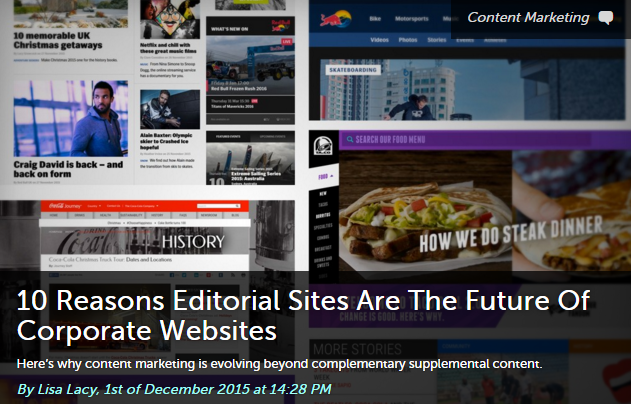
Brands like Red Bull, Coke and, more recently, Taco Bell are leading the charge toward editorial-driven websites that forsake traditional corporate site content for the stories, images and videos that were once the purview of blogs and news sites.
When Coke debuted its revamped site in 2012, the move was still perceived as somewhat radical. Now, however, marketing experts say a veritable evolution is underway.
Here are 10 changes driving this shift toward wholly editorial brand sites – which eclipse supplemental editorial content – and why marketers must evolve or die.
1. Value
Marcos Sanchez, vice president of communications at technology-focused venture capital firm Runa Capital, said having a corporate website simply doesn’t cut it anymore as marketers look to provide more value with the result being that more companies are looking at content marketing somewhere between editorial and advertorial.
According to Sanchez, most brands understand consumers don’t want to just go to a company site, but rather want a reason to be there.
“Whether that’s custom games, online ordering, customized products or editorial content, it’s important to give people a reason to go to your site, and just posting a traditional website isn’t enough,” he said.
This is also the reason older digital marketing tactics are dying out.
“Obnoxious banner ads that force accidental clicks do nothing more than artificially skew click-through rates. They provide no value to the consumer. It’s exactly why Apple is pushing a banner-free ecosystem,” said Kyle Reyes, president and creative director of The Silent Partner Marketing. “You could care less about what tech companies want…but we need to acknowledge the paradigm shift. The three top downloaded apps in the Apple Store recently have all been ad-blocking software. Clearly there’s a strong wave happening at the consumer level and it will continue to fuel a shift towards content-driven websites that actually bring value to the consumer.”
Melanie Deziel, director of creative strategy at Time Inc., too, notes advertisers must provide more value in part because consumers have an incredible array of resources outside of a corporate website to learn about a given brand’s products or services.
2. Social
Per John Nesler, researcher and content writer for online marketing company Creative California, editorial-driven websites are simply a natural progression from brands developing their own social feeds.
“At some point, the breadth and creativity of their sponsored content becomes so varied that it makes sense to develop their own independent pseudo-entertainment/editorial outlet to contain all of it,” he said.
Elizabeth Clor, senior director of content marketing at customer experience management firm Clarabridge, agrees.
“Consumers now follow their favorite brands on Facebook, Instagram, etc. and so they have little reason to actually visit their websites, unless they are making a purchase,” she said.
3. Influence
For her part, Rebecca Brooks, partner at market research firm Alter Agents, notes consumers have access to tons of information about brands that does not come from the brands themselves and word of mouth – particularly digital word of mouth – is a huge influencer.
“In the past, you only talked to people you knew, but now there’s a vast army of strangers that have already tried a product and given feedback,” Brooks said. “Irrespective of the brand, digital word of mouth is becoming the dominant influencer in making purchases, so how does a brand stay relevant when it is not included in the conversation? Editorial is one of the paths to that.”
4. Mobile
Further, Mat Zucker, a partner at brand and marketing consultancy Prophet, said modern mobile-first customer experiences have put huge question marks over websites in general.
In other words, brands must now question how the experience changes when visits aren’t from the desktop and what the value proposition is of a website versus an app or other owned channels.
5. Authority
In addition, Christophe Jammet, director of social media and mobile at strategy firm Discover Digital Group, said if brands invest in high quality, editorially-driven content, consumers will associate their positive content experiences with your brand.
Further, Jason Brewer, CEO of digital agency Brolik, said content hubs that are designed well and filled with good content become consumer magnets and increase a brand’s authority.
“These content hubs improve the perception of a brand but can also have technical benefits like increased domain authority and organic search traffic if the content hits on popular questions and interest topics of the target audience,” he said.
6. Journalism
News organizations are also responsible for this shift toward editorial-driven sites as they shift away from reporting with neutrality, according to Nesler.
“News stories have long been shaped by the biases of the corporations and brands that partially or wholly owned the media outlets which produce those stories,” Nesler said. “So, in a sense, Taco Bell, Coke and other corporations are meeting these news outlets in the middle.”
Further, more biased posts are more likely to generate desirable marketing outcomes, he said.
“Looking at social media, it’s clear that biased news articles, opinion pieces and other content, which all amount to corporate-sponsored content, get tremendous traction, being quickly shared by millions of people,” Nesler said. “It makes perfect sense for brands to get into the game by developing content that isn’t focused entirely on their products, but instead riffs on the interests of their targeted consumers. People aren’t going to share a Coke commercial on Facebook, but they’re quite liable to share an interesting article that just so happens to be produced by Taco Bell, or a weird and quirky video made by Coke.”
7. Channels
The ad space is evolving such that marketers now have to circumvent both technological and mental ad blockers, according to startup marketing consultant Nigel Ravenhill.
“So you have the rise of new advertising channels and formats, which aren’t what anyone older than 40 would even recognize as advertising – or define as advertising,” Ravenhill said. “As advertising morphs beyond its historically recognizable shape, using channels that didn’t exist in the 20th century, managed storytelling like [Coke and Taco Bell] will be increasingly central to companies.”
Brewer, too, said the shift away from traditional corporate websites points to a change in marketers’ mindsets.
“Brands are finally catching on to the fact that their customers don’t want to be sold to and they don’t really care about the ‘corporate’ runnings of their business,” he said. “Brands that focus on the needs of customers and strive to create content that adds value to their lives are seeing customer loyalty and engagement improve.”
8. Consumption
We are living in the “It’s All About Me Economy,” in which consumers want data, information, and content when and where they want it, Reyes said.
“They want to consume stories and infotainment that will help enhance their lives and their buying decisions,” he said.
9. Perception
Aaron Watters, vice president of SEO firm Leadhub, said big brands have put in years of work toward product awareness and are now focused on top of mind awareness.
“The more engaging a big brand’s content is and the more they own top of mind awareness, the more difficult it is for new competitors to enter the market,” he said.
He uses Red Bull as an example.
“For years, they’ve been engaging their audience with amazing content from extreme sports,” he said. “If you visit their U.S. site it’s all about content that their audience is interested in – it’s more of a blog than a sales platform. In fact, their primary navigation doesn’t even include information about their products.”
10. Humanization
For his part, content marketing strategist Henry Adaso said it’s the need to become more personable that is driving this trend.
“People don’t traditionally view brands as people. So storytelling and more personable content are ways for brands to connect with the everyday customer in the social media age,” he said. “The perception is that brands don’t care about people. People care about people. So how can brands show that they care? By creating personable content and by partnering with social media talent.”
What do you think? Are traditional corporate websites doomed?
